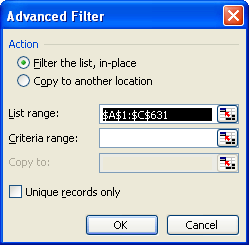Please Note: This article is written for users of the following Microsoft Excel versions: 97, 2000, 2002, and 2003. If you are using a later version (Excel 2007 or later), this tip may not work for you. For a version of this tip written specifically for later versions of Excel, click here: Segregating Numbers According to Their Sign.
Written by Allen Wyatt (last updated January 14, 2023)
This tip applies to Excel 97, 2000, 2002, and 2003
Are you working with a large set of data consisting of mixed values, some negative and some positive, that you want to separate into columns based on their sign? There are several ways this can be approached. One method is simply to use a formula in the columns to the right of the mixed column. For instance, if the mixed column is in column A, then you could place the following formula in the cells of column B:
=IF(A2>0,A2,0)
This results in column B only containing values that are greater than zero. In column C you could then use this formula:
=IF(A2<0,A2,0)
This column would only contain values less than zero. The result is two new columns (B and C) that are the same length as the original column. Column B is essentially the same as column A, except that negative values are replaced by zero, while column C replaces positive values with zero.
If you want to end up with columns that only contain negative or positive values (no zeroes), then you can use the filtering capabilities of Excel. Assuming the mixed values are in column A, follow these steps:

Figure 1. The Advanced Filter dialog box.
You now have the desired two columns of positive and negative values. You can also delete the cells at E1:E2 if you desire.
ExcelTips is your source for cost-effective Microsoft Excel training. This tip (3198) applies to Microsoft Excel 97, 2000, 2002, and 2003. You can find a version of this tip for the ribbon interface of Excel (Excel 2007 and later) here: Segregating Numbers According to Their Sign.

Excel Smarts for Beginners! Featuring the friendly and trusted For Dummies style, this popular guide shows beginners how to get up and running with Excel while also helping more experienced users get comfortable with the newest features. Check out Excel 2019 For Dummies today!
You can easily set up a formula to perform some calculation on a range of cells. When you copy that formula, the copied ...
Discover MoreSometimes making sure that a reference in a formula doesn't get changed is not as simple as putting dollar signs in front ...
Discover MoreExcel is very good at counting things, even when those things need to meet specific criteria. This tip shows how you can ...
Discover MoreFREE SERVICE: Get tips like this every week in ExcelTips, a free productivity newsletter. Enter your address and click "Subscribe."
There are currently no comments for this tip. (Be the first to leave your comment—just use the simple form above!)
Got a version of Excel that uses the menu interface (Excel 97, Excel 2000, Excel 2002, or Excel 2003)? This site is for you! If you use a later version of Excel, visit our ExcelTips site focusing on the ribbon interface.
FREE SERVICE: Get tips like this every week in ExcelTips, a free productivity newsletter. Enter your address and click "Subscribe."
Copyright © 2026 Sharon Parq Associates, Inc.
Comments